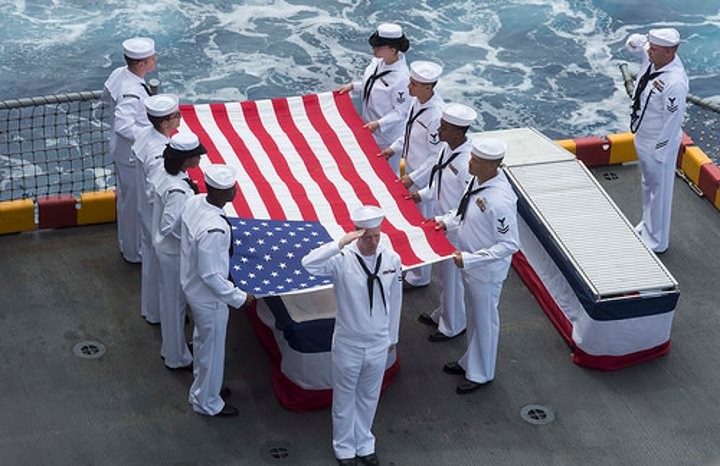
Honoring deceased naval veterans with a burial at sea is a time-honored tradition that can be traced back as far as ancient Rome and Greece. A Naval burial employs traditions that not only honor the service of the departed but also signifies all military personnel’s commitment to the departed’s legacy.
Shared Traditions that Honor the Fallen
A Naval burial at sea is marked by traditions followed by all branches of the US military.
Reversal of Rank - the pallbearers, as well as all other uniformed mourners, are positioned in accordance with the reverse order of their rank. Reversal of rank follows an ancient Roman custom during the feast of Saturn that signified that all are equal at death.
Three Volley Salute - The number three harkens back to many ancient traditions. Ancient Roman funeral rites included mourners speaking the name of the dead three times and repeating the word vale (Latin for farewell) as the mourners left the tomb. The three volleys can be traced back to the dynastic wars of Europe during momentary truces to remove the wounded and dead. At Navy military funerals on land or at sea, three volleys are fired by a seven riflemen firing detail.
Taps - Taps was played first at a military funeral in Virginia as a substitute for the three volley salute so that the battery’s location would not be detected by the enemy. A military bugler plays taps at a naval burial at sea between the three volley salute and presentation of the national ensign (flag).
The National Ensign - Sometimes called the American flag is draped over the casket with the union blue at over the head and left shoulder of the deceased. Following Taps, the flag is folded thirteen times (for the Original thirteen colonies) and folded into a triangle (symbolizing the Patriots of the American Revolution tri-cornered hat).
Burial at Sea
Also called the “at sea disposition,” a navy burial at sea is performed on a U.S. Naval Vessel. The tradition of burial at sea goes back as long as people have gone to sea.
Since the committal ceremony occurs while the ship is deployed, family members are not allowed to be present. However survivors are notified by the ship’s commanding officer as to the date, time, and longitude and latitude of the burial after the committal service.
Family members can choose to observe the ceremony from a civilian ship that is positioned close to the military ship, should it be near enough. There are also civilian organizations that provide burial at sea from a civilian vessel.
Eligibility - Those eligible for a naval burial at sea include active duty members of all branches of the U.S. military, veterans who were honorably discharged and retirees, civilian marine personnel of the Military Sealift Command, and dependent family members of active duty personnel, veterans of the uniformed services, and retirees.
First Steps - The Person Authorized to Direct Disposition (PADD) should contact the Navy and Marine Corps Mortuary Affairs office after the death of an eligible deceased veteran to request a packet for additional information. The Navy and Marine Corps Mortuary Affairs can be reached at 1-866-787-0081.
If the PADD provides a burial flag, it will be flown at half-mast during the committal service and then returned to the family. Should a flag not be provided, one will be provided by the Navy. However, it will not then be returned after the ceremony.
Documents that are required for a Navy Veteran Burial at Sea Ceremony are a:
-
Photocopy of the death certificate
-
Cremation certificate or burial transit permit
-
Discharge certificate, copy of DD Form 214, discharge certificate, or retirement order
Cremation remains along with the completed Burial at Sea Request package should be forwarded to the Burial at Sea Coordinator at the desired port of embarkation. The ports of embarkation for a naval burial at sea are Norfolk Va, Jacksonville FL, San Diego CA, Bremerton WA, and Honolulu, HI.
